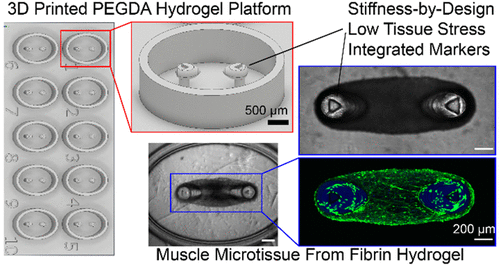当前位置:
X-MOL 学术
›
Biomacromolecules
›
论文详情
Our official English website, www.x-mol.net, welcomes your
feedback! (Note: you will need to create a separate account there.)
3D Printed Hydrogel Multiassay Platforms for Robust Generation of Engineered Contractile Tissues.
Biomacromolecules ( IF 5.5 ) Pub Date : 2019-12-20 , DOI: 10.1021/acs.biomac.9b01274 Rie Kjær Christensen 1, 2 , Christoffer von Halling Laier 1 , Aysel Kiziltay 1 , Sandra Wilson 2 , Niels Bent Larsen 1
Biomacromolecules ( IF 5.5 ) Pub Date : 2019-12-20 , DOI: 10.1021/acs.biomac.9b01274 Rie Kjær Christensen 1, 2 , Christoffer von Halling Laier 1 , Aysel Kiziltay 1 , Sandra Wilson 2 , Niels Bent Larsen 1
Affiliation

|
We present a method for reproducible manufacture of multiassay platforms with tunable mechanical properties for muscle tissue strip analysis. The platforms result from stereolithographic 3D printing of low protein-binding poly(ethylene glycol) diacrylate (PEGDA) hydrogels. Contractile microtissues have previously been engineered by immobilizing suspended cells in a confined hydrogel matrix with embedded anchoring cantilevers to facilitate muscle tissue strip formation. The 3D shape and mechanical properties of the confinement and the embedded cantilevers are critical for the tissue robustness. High-resolution 3D printing of PEGDA hydrogels offers full design freedom to engineer cantilever stiffness, while minimizing unwanted cell attachment. We demonstrate the applicability by generating suspended muscle tissue strips from C2C12 mouse myoblasts in a compliant fibrin-based hydrogel matrix. The full design freedom allows for new platform geometries that reduce local stress in the matrix and tissue, thus, reducing the risk of tissue fracture.
中文翻译:

用于可靠生成工程收缩组织的3D打印水凝胶多重测定平台。
我们提出了一种可重复制造的具有肌肉组织剥离分析的可调机械性能的多测定平台的方法。该平台是由低蛋白结合性聚乙二醇(二甘醇)二丙烯酸酯(PEGDA)水凝胶的立体平版印刷3D打印产生的。先前已经通过将悬浮的细胞固定在具有嵌入的锚定悬臂的密闭水凝胶基质中来促进肌肉组织条的形成来设计收缩性微组织。限制区和嵌入式悬臂的3D形状和机械性能对于组织的坚固性至关重要。PEGDA水凝胶的高分辨率3D打印提供了充分的设计自由度来设计悬臂刚度,同时最大程度地减少了不必要的细胞附着。我们通过在基于纤维蛋白的水凝胶基质中从C2C12小鼠成肌细胞产生悬浮的肌肉组织条来证明其适用性。完全的设计自由度允许采用新的平台几何形状,从而减少基质和组织中的局部应力,从而降低组织破裂的风险。
更新日期:2019-12-21
中文翻译:

用于可靠生成工程收缩组织的3D打印水凝胶多重测定平台。
我们提出了一种可重复制造的具有肌肉组织剥离分析的可调机械性能的多测定平台的方法。该平台是由低蛋白结合性聚乙二醇(二甘醇)二丙烯酸酯(PEGDA)水凝胶的立体平版印刷3D打印产生的。先前已经通过将悬浮的细胞固定在具有嵌入的锚定悬臂的密闭水凝胶基质中来促进肌肉组织条的形成来设计收缩性微组织。限制区和嵌入式悬臂的3D形状和机械性能对于组织的坚固性至关重要。PEGDA水凝胶的高分辨率3D打印提供了充分的设计自由度来设计悬臂刚度,同时最大程度地减少了不必要的细胞附着。我们通过在基于纤维蛋白的水凝胶基质中从C2C12小鼠成肌细胞产生悬浮的肌肉组织条来证明其适用性。完全的设计自由度允许采用新的平台几何形状,从而减少基质和组织中的局部应力,从而降低组织破裂的风险。











































 京公网安备 11010802027423号
京公网安备 11010802027423号